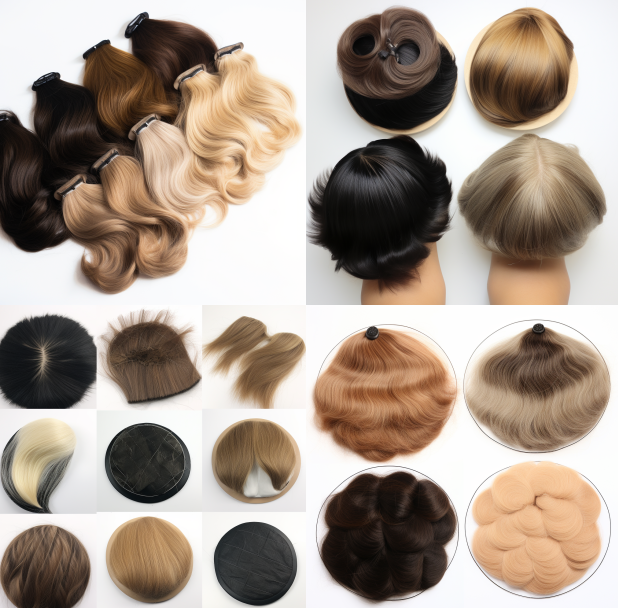What are the Different Bases for Hair Toppers - Hair System Base Types
Hair toppers, also known as hair systems or hair pieces, come in various base constructions that determine their durability, comfort, and attachment methods. Understanding the different hair base types is crucial in order to choose the right hair system that suits your unique requirements. In this article, we will explore some of the most popular hair system base types and their purposes.

What are the Different Bases for Hair Toppers?
Hair toppers and hair systems use different types of base materials to attach the hair strands and allow the piece to lay smoothly on the head. The base plays a major role in the look, feel, and performance of a hair topper or hair system. Selecting the right base type can optimize the naturalness, comfort, and longevity of your hair addition. Here is an overview of the most common hair systems base types.
Lace Bases
A lace base features strands of hair individually hand-tied to a base material made of delicate lace. Lace bases are known for:
Ultra fine, sheer lace foundation
Each hair strand is knotted through the lace
Lightweight and breathable
Flexible to mold to head shape
The hand-tied construction gives a very natural look, similar to your scalp. Lace bases are also airy for comfort in warm weather.
Pros of Lace Bases
Mimics a natural hairline
Allows the scalp to breathe
Comfortable for all-day wear
Cons of Lace Bases
Knots may be visible at hair part
More delicate and prone to tearing
Usually more expensive
Monofilament Bases
A monofilament base uses a fine, mesh-like material as the base. Hairs are intricately woven through the delicate netting. Attributes include:
Made of soft mesh or microfine transparent material
Hairs are individually hand-tied into the material
Allows multidirectional hair parting
Durable and long-lasting
Monofilament bases provide natural movement and customize styling options. They are also strong and easy to maintain.
Pros of Monofilament Bases
Natural-looking hair growth pattern
Can part hair in any direction
Smooth, soft, and comfortable
Strong and durable for longevity
Cons of Monofilament Bases
Less breathable than lace
Parting areas tend to be thicker
Silk Top Bases
A silk top base features a layer of silk material at the crown designed to hide knots and create a realistic scalp. Key attributes:
Layer of silk fabric on top hide knots
Mimics the look and feel of skin
Hairs individually tied to a thin mesh underneath
Part hair freely in any direction
The silk layer yields the most natural scalp appearance. Partings seamlessly blend with the skin.
Pros of Silk Top Bases
Appears just like a natural scalp
Hides knots perfectly
Enables multidirectional parting
Cons of Silk Top Bases
Can feel warm in hot weather
Multiple layers can inhibit airflow
Not as breathable as lace or monofilament
Skin Bases
Skin bases use an ultra-thin silicone or polyurethane skin material as the base, designed to replicate the look and feel of real skin. Features include:
Made of soft, flexible skin-like silicone or polyurethane
Hairs are injected or knotted into the material
Mimics the appearance of a natural hairline and scalp
Latex-free and hypoallergenic
Skin bases move and blend just like real skin and hair for an ultra-realistic integration.
Pros of Skin Bases
Seamlessly blends with your scalp
Creates natural hair growth patterns
Lightweight and lays flat
Cons of Skin Bases
Can retain heat
More delicate and prone to tearing
Shorter lifespan than other bases
Comparing the Pros and Cons of Different Types of Hair Bases
| Base Type | Pros | Cons |
| Lace | Natural looking hairline, very breathable | Visible knots, delicate |
| Monofilament | Natural movement, customizable parting, durable | Can lack breathability |
| Silk Top | Hides knots, mimics scalp | Multiple layers reduces airflow |
| Skin | Mimics natural hair growth, blends into skin | Can be hot, prone to tearing |
Which Hair System Base is Best?
So with all these options, which is the best base type for a hair topper or hair system? The answer depends on your needs and preferences.
Lace bases - Best choice when breathability and ultra-fine hairlines are the priority.
Monofilament bases - Optimal when you need strength, longevity, and flexible styling.
Silk top bases - Ideal for perfectly concealing knots while closely mimicking the scalp.
Skin bases - Most seamless integration and natural look but less durability.
Think about lifestyle factors too. Active individuals or those in hot climates do better with lace or monofilament for ventilation. Frequent style switchers get more versatility from monofilament or silk top constructions.
Discuss your needs with a hair topper specialist and they can recommend the optimal base type for your situation.
Tips for Choosing the Right Hair Topper Base
Follow these tips for selecting an ideal hair topper or hair system base for your needs:
Consider breathability if wearing in warm weather
Choose lace or silk if concealing knots is critical
Monofilament or silk allow parting flexibility
Skin bases offer the most seamless integration
Assess durability based on your lifestyle
Get an extended lace front for natural hairlines
Ask a stylist to recommend the right base type for you

